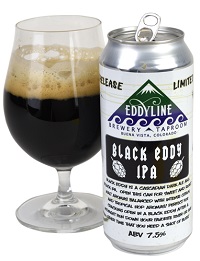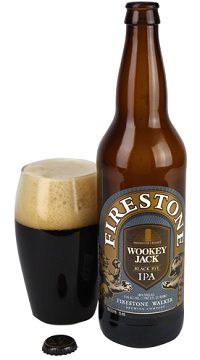Are Dark Days Ahead for Black IPAs?
Of all the choices available when a customer walks into a bar or brewery, one receives a steady amount of attention: IPAs.
Maybe because “hoppy” can be a catch-all term that easily points toward particular flavor profiles or, as IPA accounts for about a third of “craft”-defined dollar sales, the piney, tropical or juicy flavors of the style offer familiar choices.
Whatever the reason may be, people aren’t shy about filling up their glasses with a classic India pale ale or one of its many variations. IRI, a market research firm that tracks retail sales data, now maintains eight categories for IPA, including the wide-open “other” for whatever hop-forward concoction a brewer can dream up.
But for all the style’s success, the shine on one of IPA’s sibling styles is now looking a bit dull. Once a hot trend, the black IPA isn’t what it used to be.
“It’s definitely died off over the last couple years,” says Pat Brophy, beer buyer for Binny’s Beverage Depot, an Illinois alcohol retailing chain. “It was the hot new thing in IPA in 2008 or 2009, but IPA lovers are constantly trying to find the hot new thing. People who were once interested in trying the next black IPA are now waiting for the next fruited IPA or the next single-hop IPA.”
There are relatively few mysteries in beer, truth generally coaxed out through science or sales data. But one question—what’s up with the black IPA?—seems to have different answers.
Several measures point to a decline. In the first seven months of 2016, the dollar value of black IPA sales tracked by IRI was down nearly 16 percent, the only substyle of IPA to slip. After black IPA grew in number of supermarket-tracked brands from 2011 (15) to 2014 (43), the total number of brands remained steady in 2014 (43), 2015 (46) and 2016 (43). During that same time, all styles of IPA added nearly 400 new brands in supermarkets.
It’s the same story on Untappd, the app that allows users to check into beers they’re drinking. In 2014, 1.2 percent of all check-ins were black IPAs, dropping to 1 percent in 2015 and 0.8 percent through November 2016.
Meanwhile, in both number of brands in supermarkets and Untappd attention, the session and fruit IPA substyles have continued to grow alongside the long-tenured American and imperial versions of the style.
But just because black IPA is down, that doesn’t mean it’s out.

Pouring Tuxedo Tshirt at Circle Brewing Co. in Austin, Texas. (Photo courtesy Alexa Gonzalez Wagner/Circle Brewing Co.)
In fall 2016, Sierra Nevada Brewing Co. unveiled labeling for its own black IPA, part of a January 2017 release in an IPA variety pack. Full Sail Brewing Co. also announced its Shortest Day Cascadian Dark Ale, available November 2016 to February 2017, as part of its Brewmaster Reserve series. Style names for black IPA can be interchangeable and can also include Cascadian dark ale and American dark ale. Sales of the style have proved strong enough for Circle Brewing Co. that the Austin, Texas, brewery will shift its seasonal Tuxedo Tshirt black IPA to year-round status.
“For some reason, black IPA tends to play to a much larger crowd in Texas than its darker counterparts because it associates with the IPA style and people are willing to give it a shot,” says Ben Sabel, president and co-founder of Circle.
Tuxedo Tshirt’s transition to a core beer presents a unique situation in Austin, where many of the city’s most popular beer brands skew lighter or less-focused on big hop flavor, including pilsner. More than 75 percent of Circle Brewing’s sales come from two brands, Blur Texas Hefe and Envy Amber Ale, so Circle’s black IPA presents a unique option. Sabel says the beer has potential to fill a void for drinkers who recognize what “IPA” means, but may be looking for a different version of the hop-forward style. After producing 120 barrels for its run in 2016, the Tuxedo Tshirt will increase to at least 600 once it transitions to a core brand sometime in 2017.
Success has been mixed for Idaho’s Grand Teton Brewing Co., which until 2016 had seen strong interest in its Trout Hop Black IPA. The brand started off as a one-time Cellar Reserve debut in 2010 and was brought into seasonal rotation in 2013. In January of 2017, the brewery announced it will discontinue Trout Hop in May. Sales of all Grand Teton’s seasonals have slowly declined, even though Trout Hop easily sold out its 150 barrels during a three-month 2016 lifespan. Before the brewery discontinued Trout Hop, Rob Mullin, brewmaster and COO, said those results prompted discussions of whether it would be viable to discontinue seasonal brands, which include an imperial IPA, an imperial red ale and a Berliner-style weisse alongside its black IPA.
“As IPAs have taken over the craft beer market, it doesn’t surprise me that some hoppy styles are taking a little bit of a back seat to others,” Mullin said. He knows from first-hand experience.
In 2016, Mullin spent months formulating Grand Teton’s first American IPA recipe to add to its core lineup. From the start, the process involved focusing on late hop additions to boost aroma and flavor—a popular tactic for today’s IPA. Whether Trout Hop stayed or was discontinued remains part of a larger discussion around the brewery’s hop-focused beers and Grand Teton’s ability to give consumers what they want.
“Other people are doing IPAs with different fruits and new hop varieties every few weeks, and in a way, those might have taken the place seasonals once had in consumer’s minds,” Mullin said.
Strangest of all in the ongoing tale of black IPA is the disappearance of two of its most prominent examples. In 2015, Stone Brewing discontinued Sublimely Self-Righteous Black IPA, citing declining sales. In 2016, Firestone Walker Brewing Co. put its Wookey Jack into “hibernation” along with two other Proprietor’s Reserve beers. Firestone made 4,000 barrels of Wookey Jack in 2013 and 2014, but reduced this to 3,000 barrels in 2015.
The loss of those two black IPAs, mentioned by brewers and drinkers alike as defining versions of the style, is an uncommon end in today’s industry.
“It is strange and a little scary to think about pulling successful beers like Wookey Jack out of the lineup, but things evolve rapidly in the craft beer world,” says Matt Brynildson, Firestone Walker’s brewmaster. For him, the loss of some beers means more attention can be paid to creations from the brewery’s research and development facility or the ever-changing recipe of Luponic Distortion IPA, one of the country’s top-selling new beer brands in 2016.
Black IPA isn’t “dead,” Brynildson says, but the dark, hoppy beers “certainly don’t fit into every occasion.”
That is, not unless you’re spending time at Greenbush Brewing Co. in Sawyer, Michigan, where Anger Black IPA holds a prominent position among the brewery’s IPA-heavy lineup. It’s one of four IPAs that make up the brewery’s best-selling brands, alongside Star Chicken Shotgun IPA, Dunegräs IPA and Brother Benjamin Imperial IPA. Anger is also one of the highest-rated, regularly available black IPAs found on online rating sites, including Untappd.
“The popularity of the style has gone down, and you don’t see as many black IPAs the past couple years, but this is our mainstay,” says Jake Demski, head brewer at Greenbush. “It’s definitely something we need to keep on.”
Sidestepping current IPA trends that focus on fruit or haziness, Demski attributes the success of Anger to its appeal to a wide audience. At Greenbush’s taproom, he’ll talk up the roasted malt character to new drinkers; to experienced hop heads, he’ll point out the 1.5 pounds of dry hops per barrel, consisting of Summit, Cascade and Columbus hops.
As Stone and Firestone’s black IPAs have gone away, Brophy, the beer buyer from Binny’s, says Anger has acted as the style’s “lead dog” in his stores. Even though national names like 21st Amendment Brewery (Back in Black) and Uinta Brewing Co. (Dubhe) still ship their black IPAs across the country, he can’t recall the last time a shopper specifically wanted the style.
“It’s not necessarily a style somebody comes in asking for,” Brophy says. “It seems kind of strange to call black IPA a ‘classic’ style, but with the speed of changes and trends, it’s almost the case at this point. Fruited IPA has sort of taken its place, for sure.”

Full Sail Shortest Day CDA
ABV: 6.6% | Cascadian Dark AleTasting Notes: A black forest of pine. It’s as equal parts roast rich espresso and chocolate as it is sweet and sharp pine. For a style that often struggles for definition, this is a beer that crystallizes all the ingredients, making no mistake that it’s an IPA and a dark beer all at once, separate but harmonious together. A full, almost creamy mouthfeel, jet black in color with a tan head that lasted for the duration of the drinking session. And at the end of it, this is the kind of beer you wish would stick around a little bit longer. –John Holl

Eddyline Black Eddy IPA
ABV: 7.5% | Black IPATasting Notes: This is definitely along the lines of what I prefer from a black IPA, with quieter overall roast letting this stay hop-focused and streamlined. The aromatics open up as this warms, offering plum and unsweetened chocolate and juicy pine-forward hops throughout. Bitter citruses and pine carry things—building to welcome, tongue-numbing levels in due time—and while this may not land as loudly as some of the others, core pine and lime zest keep it limber. –Ken Weaver

Firestone Walker Wookey Jack
ABV: 8.3% | Black Rye IPATasting Notes: Firestone recently said goodbye to Wookey Jack (along with Opal and Double Jack in its retiring Proprietor’s Reserve line), and we wanted a final taste before this headed off into the sunset, for the time being. There’s potent grapefruit rind and pine in the aromatics, while the combo of generous hopping, spicy rye and dark malts have this one leading with a bitterness that dominates from first sip to finish. Not messing around; plenty of citrus. Till next time. –Ken Weaver
Bryan Roth
Bryan Roth is a North Carolina-based writer. Find him tweeting @bryandroth. In July of 2016, Roth wrote about the life and death of beers. Read the story at allaboutbeer.net/lifeanddeath.

Love the info ….keep up the great work….thanks
The “fall” of “black IPA” coincides with a fracture in the definition of the style caused by the American Brewers Association. While most people who were serious about this style were arguing the nuances of “Black IPA” vs “Cascadian/CDA”, the Brewers Assn chose a bland middle ground they named “American Black Ale”. The style guidelines left a huge level of interpretation related to ingredients and IBUs, leaving consumers untrusting of what they were buying. It is now impossible to trust commercial examples of black IPA or CDA because they may fall anywhere on the “ABA” spectrum.